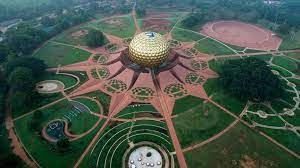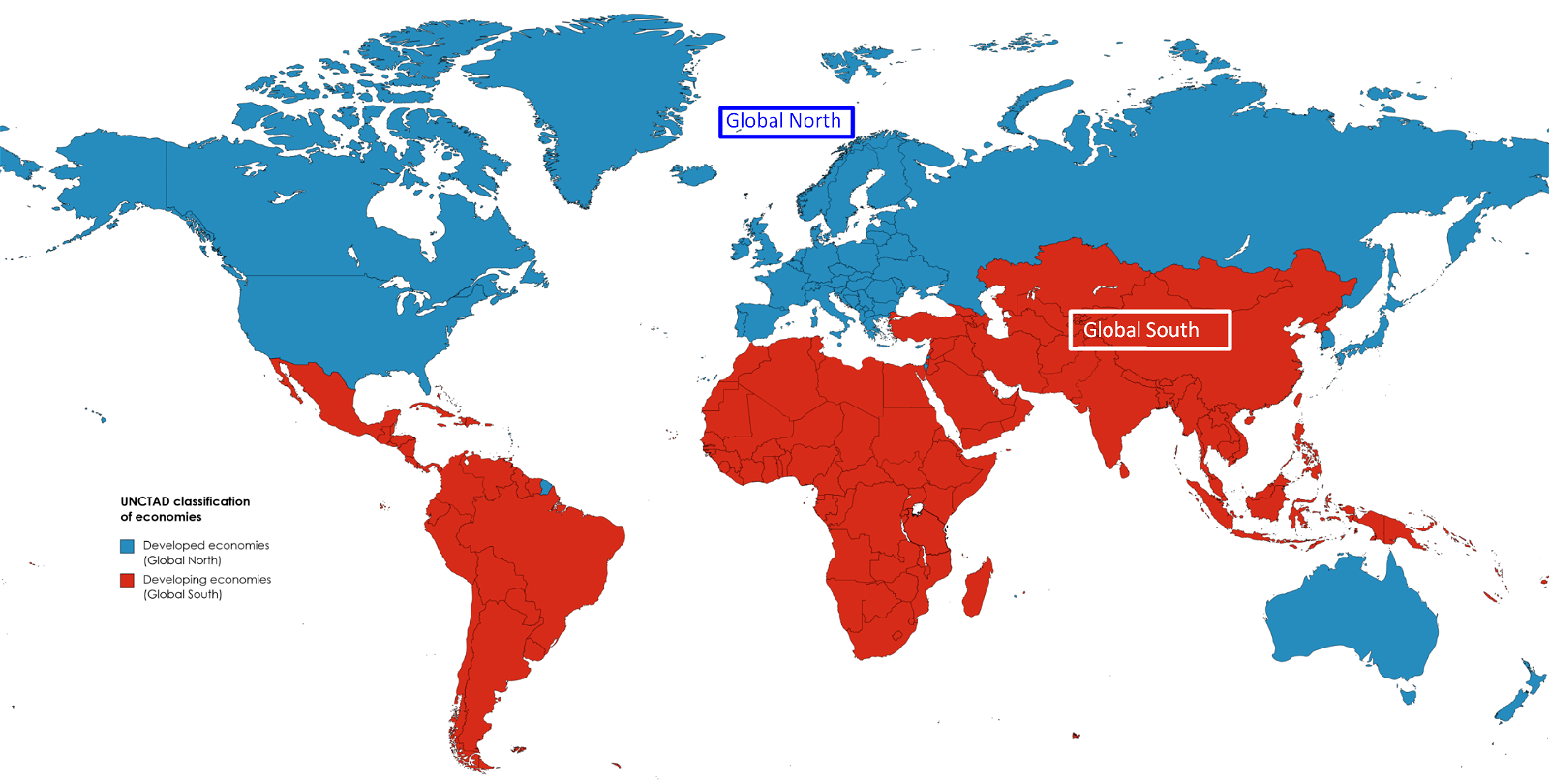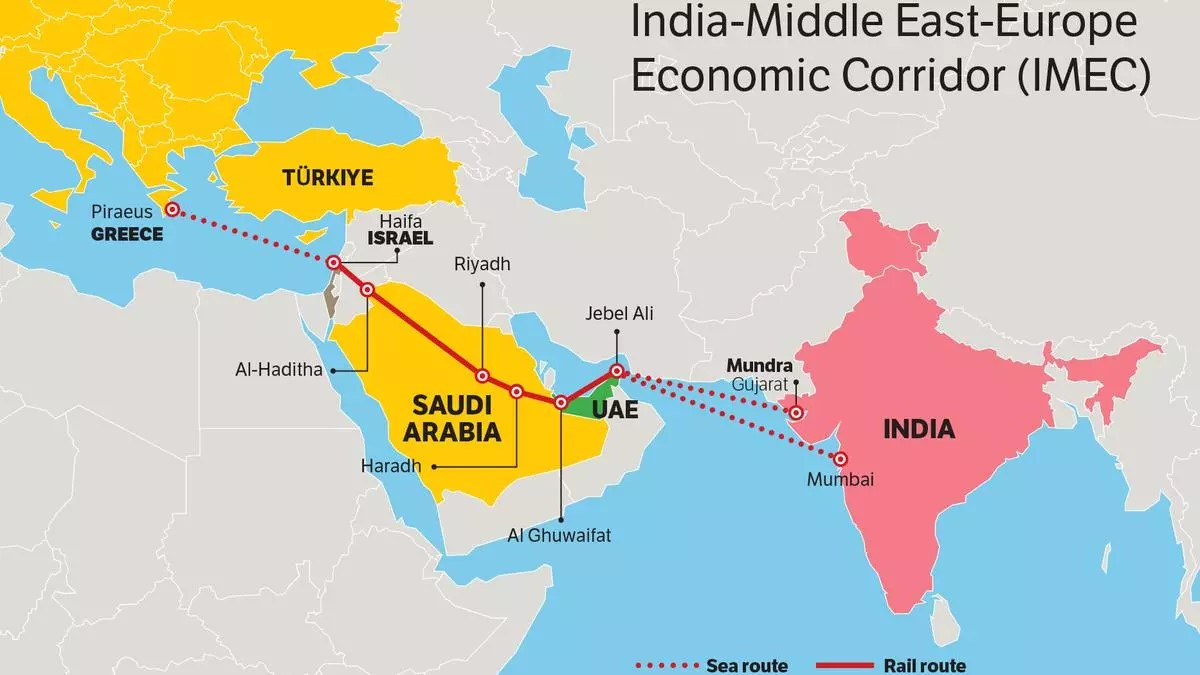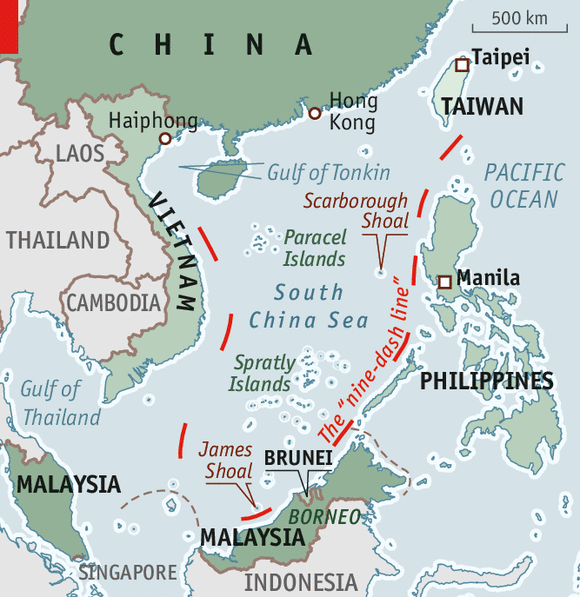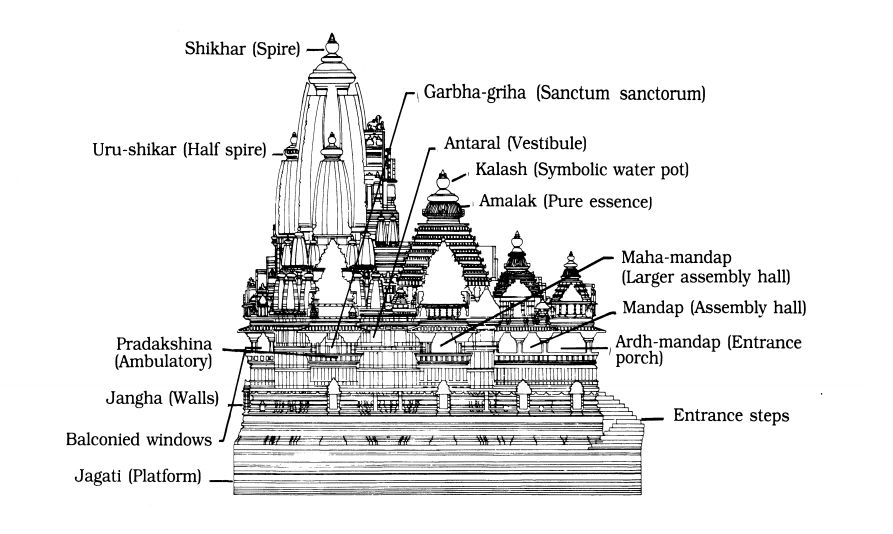
Current Affairs August 17, 2023: Red Fort (Lal Qila), Gender Stereotypes, Caste-Based Survey by Bihar, Uniform Civil Code, OBC Reservation, PM Vishwakarma, ZTF Augmented Reality Transient Hunter
Subscribers of "Current Affairs" course can Download Daily Current Affairs in PDF/DOC
Subscribe to Never Miss an Important Update! Assured Discounts on New Products!
Must Join PMF IAS Telegram Channel & PMF IAS History Telegram Channel
{GS1 – MIH – Events – 2023/08/17} How Red Fort Became the Venue for the PM’s Independence Day Speech
- Context (IE): PM Narendra Modi hoisted the tricolour and addressed the nation from the Red Fort in Delhi on India’s 77th Independence Day.
- Jawaharlal Nehru started the tradition in 1947, although his address was on August 16th, a day after the official handover of power. In his speech, he called himself the Pratham Sevak of India.
How Delhi became the Seat of Power in India?
- Red Fort becoming an integral part of Independence Day is related to Delhi becoming the seat of power in India.
Delhi Sultanate (1206-1506)
- Under the Delhi Sultanate, Delhi became a significant capital city from where north India was ruled.
Mughal Period
- Babur, the founder of the Mughal dynasty, was the first to refer to Delhi as the ‘capital of all Hindustan’ in the 16th century.
- Though the Mughals, under Akbar shifted their capital to Agra, they continued to be seen as the rulers of Delhi.
- Finally, under Shah Jahan, Delhi became the Mughal capital once again with the establishment of Shahjahanabad in 1648 (present Old Delhi).
- He commissioned construction of the Red Fort when he decided to shift his capital to Delhi.
- The Mughals continued to rule from the Red Fort till 1857.
Sepoy Mutiny of 1857
- Though during the British rule, power of the Mughal rulers waned, they continued to be recognised as the symbolic rulers of India.
- Due to this reason, during the Sepoy Mutiny, aged Mughal Emperor Bahadur Shah Zafar was declared as the king by mutineers.
- After suppressing the mutiny British razed the Red Fort and surrounding areas.
- In the years following 1857, the British systematically relegated Delhi to a minor provincial town.
Delhi as the Capital of British India
- British decided to shift their capital to Delhi from Calcutta in 1911.
- They built a grand new city which got completed in 1930.
How Red Fort Became the Symbol of Power in Modern India?
- The Red Fort would return to the forefront of public consciousness when the public trials of the Indian National Army (INA) were held at the Red Fort.
- This public trial caused an outpouring of sympathy for the INA and fuelled nationalist sentiments.
- The trials firmly established the Red Fort as a symbol of power and resistance in the Indian minds.
- It is in this context Pt. Nehru decided to hoist the flag over the Red Fort in 1947.
{GS2 – Empowerment – Women – 2023/08/17} Gender Stereotypes
- Context (TH I IE): SC has published a handbook that includes a list of Gender-Biased Terms and recommends alternative words/phrases that can be used instead.
- Gender stereotypes are assumptions / preconception / generalized view about the characteristics/attributes that individuals of particular gender have, or the roles that they should perform.
- The SC Handbook aims to eliminate the use of gender-stereotypical language in judgments, orders, and court pleadings by the judiciary and legal community. For E.g.
| Original Term | Revised Term |
|
Seductress |
Woman |
|
Whore |
|
|
Women of Loose Morals |
|
|
Hooker |
Sex Worker |
|
Prostitute |
|
|
Eve-Teasing |
Street Sexual Harassment |
|
Housewife |
Homemaker |
Why is it important for judges to use the right words?
- The language of a judge reflects not only their interpretation of the law but also their perception of society. It transmits the ultimate intention of the lawmaker or the judge to the nation.
- Even when using stereotypes does not alter the outcome of a case, stereotypical language may reinforce ideas contrary to our constitutional ethos.
- Language is critical to the life of the law (Essay topic). Words are the vehicle through which the values of the law are communicated.


{GS2 – MoHUA – Schemes – 2023/08/17} PM e-Bus Sewa
- Context (IE): The Union Cabinet has approved the PM e-Bus Sewa Scheme.
- The PM e-Bus Sewa scheme is an initiative to promote green mobility by deploying electric buses.
- The scheme is under the Ministry of Housing & Urban Affairs.
- The Scheme would have an estimated cost of Rs.57,613 crore, out of which support of Rs.20,000 crore will be provided by the Central government, which will support bus operations for 10 years.
- The scheme will be implemented in two phases:
- In the first phase, 10,000 e-buses will be deployed in 169 cities using a PPP model.
- In the second phase, Infrastructure will be upgraded in 181 other cities to support the deployment of e-buses.
- States or cities will run the bus services and pay for the bus operators. The central government will support by providing subsidies, as mentioned in the scheme.
- The scheme will cover:
- Cities with a Population of three lahks and above.
- All the capital cities of UT
- Northeastern and hill States.
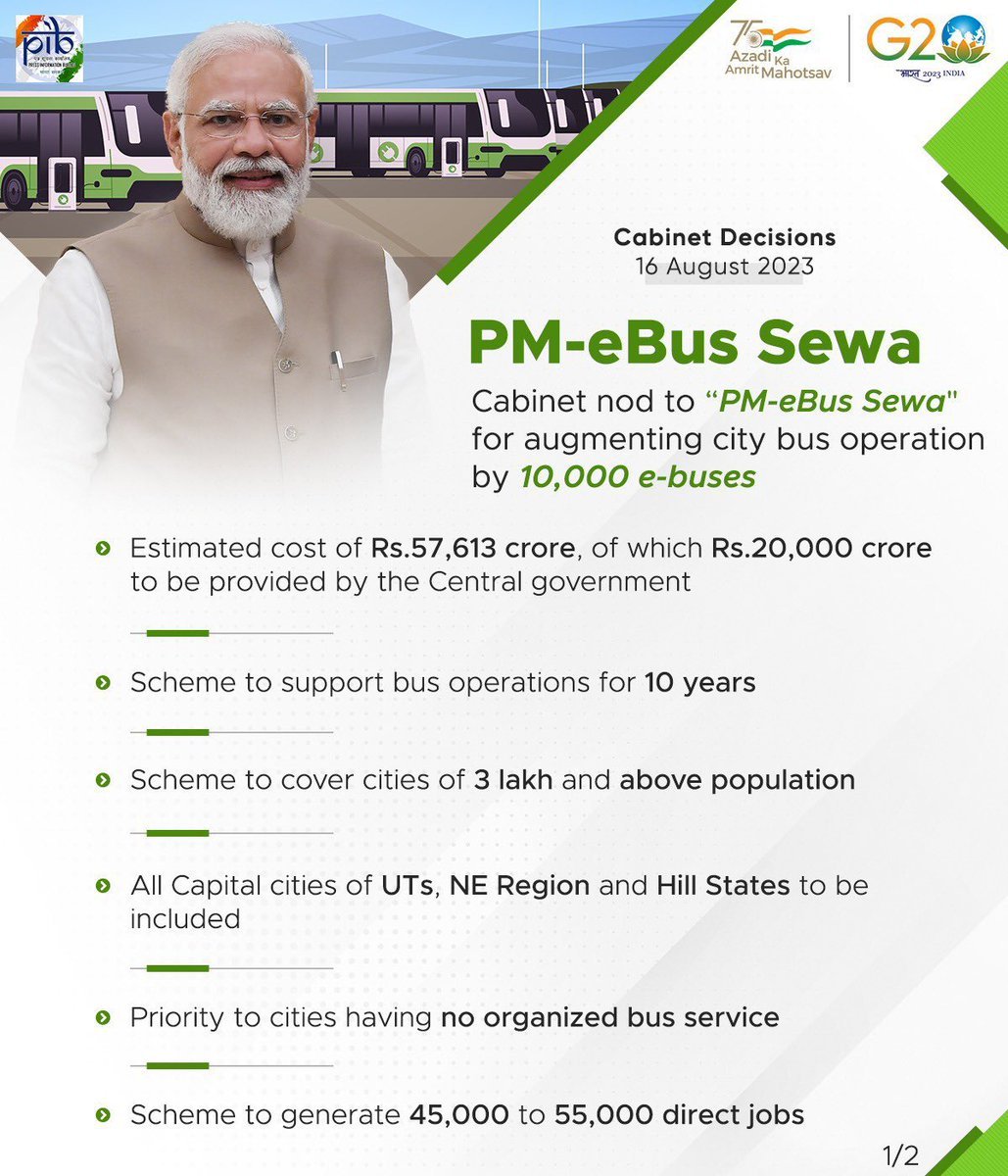

{GS2 – MoWCD – Scheme – 2023/08/17} Koosina Mane
- Context (TH): The Karnataka government announced plans to set up “Koosina mane” (child homes or creches) for children of working mothers.
- It aims to provide healthcare, nutrition, and safety for children whose mothers are employed under the Mahatma Gandhi National Rural Employment Guarantee Act (MGNREGA).
Similar Scheme by Centre: Palna – Creche Facility
- It is a centrally sponsored scheme implemented by the Ministry of Women and Child Development.
- Crèches are designed to provide group care to children up to 6 years of age.
- It enables parents to leave their children while they are at work.
Objectives
- To provide day-care facilities for children (6 months to 6 years) of working mothers.
- To improve the nutrition and health status of children.
- To promote physical, cognitive, social, and emotional development of children.
- To educate and empower parents /caregivers for better childcare.
Services
- Daycare Facilities including Sleeping Facilities.
- Early Stimulation for children below 3 years and Pre-school Education for 3 to 6 years old.
- Supplementary Nutrition (to be locally sourced).
- Growth Monitoring.
- Health Check-up and Immunization.
Benefits
- Child homes and group care for children will boost women’s labour force participation.
- It will reduce the strain women encounter as they balance childcare and paid work.
- It can address concerns of safety, nutrition, and overall well-being of the child.
{GS2 – Polity – IC – 7th Sch – 2023/08/17} Caste-Based Survey by Bihar
- Context (TH | TH | TH): The SC is set to hear a batch of petitions challenging the Patna High Court’s verdict upholding the Bihar government’s ongoing caste survey.
- The Bihar Government conducted a caste-based survey in January 2023.
- On May 4, the Patna HC stayed the caste-based census in its interim order.
- On Aug 1, the Patna HC upheld the caste-based survey and allowed its continuation as it is aimed at Development with Justice.
Grounds on which the petition was filed in the HC
Right to privacy
- The petitioners argued that the right to privacy of those surveyed would be infringed due to the queries concerning their religion, caste, and monthly income.
- The HC reiterated that permissible restrictions could be imposed on the fundamental right, in the state’s legitimate interests, provided they are proportional and reasonable.
- It clarified that the data is being collected to identify the economic, educational, and other social aspects of different communities which require further action by the State for their upliftment.
Powers of the state to carry out such a survey
- The petitioner argued that Entry 69 of the Union List of Seventh Schedule of IC contains the Centre’s exclusive power to conduct a census.
- However, Entry 45 of the Concurrent List confers power to both Centre and the states to collect statistics for any matter listed in List II and III of the Seventh Schedule.
- Entry 20 of the Concurrent List provides for economic and social planning.
- The court supported caste identification and ruled that the survey was needed for affirmative action according to Article 16 (equality of opportunity in matters of public employment) of IC.
The Seventh Schedule of the IC
Census and Caste data
Socio Economic and Caste Census (SECC)
|
{GS2 – Polity – IC – DPSP – 2023/08/17} Uniform Civil Code (UCC)
- Context (TH | IE): SC hailed Goa as a “shining example” of an Indian State with a functioning UCC.
- The UCC is the idea of having a common set of personal laws on marriage, divorce, inheritance, adoption, and succession that would apply to all citizens irrespective of religious affiliations.
- Underlining principle of UCC is that the laws should be gender-neutral, religion-neutral, and uniform grounds procedure for all citizens in civil matters such as marriage, divorce, etc.
Constitutional provisions
Seems to align with the idea of UCC
- Article 44 in part IV (Directive Principles of State Policy) of IC says that the state “shall endeavour to secure for the citizens a uniform civil code throughout the territory of India”.
- Part IV of IC deals with the Directive Principles of State Policy, which are not enforceable or justiciable in a court of law but are fundamental to the country’s governance.
Seems to be in contravention of the idea of UCC
- Sixth Schedule [Articles 244(2) and 275(1)] was created to conserve and protect the customary laws and practices of different communities.
- Article 25: lays down an individual’s fundamental right to religion.
- Article 26(b): upholds the right of each religious denomination or any section thereof to “manage its own affairs in matters of religion.
- Article 29: defines the right to conserve distinctive culture.
|
Arguments against UCC
- The Constituent Assembly refrained from implementing a UCC due to existing mistrust between communities. Implementing a UCC in present-day India would only exacerbate the divides.
- Certain civil laws in all communities are inseparably connected with religious beliefs and practices.
- The UCC would come in the way of Article 25-28 of IC, which guarantees the right to freedom of religion subject to public order, morality, and health.
- All Hindus are not governed by a homogenous personal law even after the enactment of the Hindu Code Bill, and so are Muslims and Christians under their personal laws.
- For instance, in the Northeast, there are more than 200 tribes with various customary laws. The Constitution itself protects local customs in Nagaland.
UCC and Tribal rights
- Provisions of the Hindu Marriage Act, 1955 and the Hindu Succession Act, 1956, do not apply to any Scheduled Tribe unless the Central Government explicitly directs the same.
- Many tribal groups fear that the UCC may dilute tribal customary laws and rights.
Plurality is a common feature across domains
- India does have uniformity in most criminal and civil matters. However, states have made over 100 amendments to the CrPC and IPC and several amendments to civil laws.
- If plurality exists in already codified civil and criminal laws, how can the concept of ‘one nation, one law’ be applied to diverse personal laws of various communities?
Arguments for UCC
- UCC would promote gender equality.
- If personal laws of inheritance, succession and so on are seen as a part of religion, then many discriminatory practices of the Hindu personal law against women could not be eliminated.
- UCC would not be against the freedom of religion as IC allowed the government to make laws covering secular activities related to religious practices if they were intended for social reform.
Supreme Court called for implementing the UCC
- In many cases, while deciding whether to give prevalence to the CrPc or the Muslim personal law, the SC called for implementing the UCC.
- SC in 2019 hailed Goa as a “shining example” of an Indian State with a functioning UCC.
-
Central government’s view
- The Central government holds that the overarching aim of the UCC is to ensure gender justice.
- The Central government told SC that IC obligated the State to have a UCC and said that people of different religions following different property/matrimonial laws was “affront to the nation’s unity”.
Constituent assembly’s view
- The framers of IC did not intend total uniformity or one law for the whole country, which is why personal laws were placed in entry 5 of the Concurrent List (hence they differ from state to state), with the power to legislate given to Parliament and State Assemblies.
Report of 21st Law Commission on UCC
- In 2018, the Law Commission issued a consultation paper instead of a final report on the UCC.
- The paper titled Reforms of Family Law argued for reforming family laws across religions through amendments and codifying personal laws to limit “ambiguity in interpretation” and application.
- Followings are some of the suggestions:
- UCC is neither necessary nor desirable at this stage.
- A unified nation did not necessarily need “uniformity”. Difference did not always imply discrimination in a robust democracy.
- Secularism could not contradict the plurality prevalent in the country. “Secularism” had meaning only if it assured the expression of any form of difference.
- Cultural diversity cannot be compromised to the extent that our urge for uniformity itself becomes a reason for threat to the territorial integrity of the nation
- Discriminatory practices within a religion should not hide behind the cloak of that faith to gain legitimacy. The discriminatory practices, prejudices and stereotypes within a particular religion and its personal laws should be studied and amended.
- Women must be guaranteed their freedom of faith without compromising their right to equality, as it would be unfair to make women choose between one or the other.
- Certain measures in marriage and divorce should be uniformly accepted in the personal laws of all religions. Some of these amendments include fixing the marriageable age for boys and girls at 18, making adultery a ground for divorce for both men and women, etc.
Portuguese Civil Code
- Portuguese Civil Code was enacted in Lisbon (Portugal) and introduced in Goa in 1870.
- Goa retained the Portuguese Civil Code even after its liberation in 1961.
- It is the only state to have a Uniform Civil Code for all religions.
Applicability
- It applies to ‘Goans’ whose either of the two parents or grandparents were born in Goa before December 20, 1961.
- Anyone who doesn’t fit the 1961 criterion isn’t governed under this Code. They are governed under different civil laws applicable in India.
Key features
- Both sons and daughters are entitled to an equal share in the ancestral property.
- Entire property can’t be disposed of through a will — a part of the estate must go to legal heirs.
- After marriage, each spouse is entitled to joint ownership of all property held by the other partner.
- They can’t sell the property without each other’s consent.
Non-Uniformity
- There are different rules and exemptions for Hindus and Catholics:
- While the Code prescribes monogamy, a Hindu male is allowed the right to bigamy under certain conditions.
- For Catholics, the church can annul a marriage through its rulings.
Moral of the story
- Even Goa, the ‘shining example’ of an Indian State with a functioning UCC, doesn’t fully stick to the notion of a completely uniform civil code.
{GS2 – Vulnerable Sections – OBCs – 2023/08/10} OBC Reservation
- Context (TH | TH | TH): Many regional caste-based parties demand a caste-based census to estimate the present population of OBCs and streamline welfare policies.
OBC Reservation Timeline
- In 1980, the Mandal Commission report recommended 27% reservation to OBCs in jobs.
- In 1990, the VP Singh Government declared a reservation of 27% in government jobs for the OBCs.
- In 1991, the Narasimha Rao Government introduced a change to give preference to the poorer sections among the OBCs.
- It added economic criteria while granting reservations to OBCs.
- It added a reservation of 10% for other Economically Backward Sections (EWSs).
- In the Indra Sawhney Judgment (1992), the SC:
- Upheld the government’s move and said that the advanced sections among the OBCs (i.e., the creamy layer) must be excluded from the list of beneficiaries of reservation.
- Held that the concept of the creamy layer must be excluded for SCs and STs.
- Struck down the 10% quota based on economic criteria.
Backward Classes (BCs) Commissions
Kaka Kalelkar Commission
- It was the first BCs Commission constituted under the chairmanship of Kaka Kalelkar in 1953.
- Discussions about the report continued for six years until it was rejected in 1961.
Mandal Commission
- The Mandal Commission was established in 1979 by the then Janata Party government.
- It estimated the OBC population at 52% (it is debatable whether the estimate holds true even today).
- It recommended a 27% reservation for OBC candidates in central educational institutions and at all levels of its services.
- It also recommended land redistribution and change in relation to production.
Rohini Commission
- The OBC reservation benefits are utilised only by a handful of OBC sub-castes, and many deserving OBCs are deprived of the reservation benefits.
- To examine this, with the President’s approval, a five-member commission (Rohini Commission) headed by former CJ of Delhi HC G. Rohini was constituted in 2017 under Article 340 of the IC.
- It was tasked with sub-categorizing the OBCs and equitable distribution of reserved benefits.
- The report of the Rohini Commission was recently submitted to President Droupadi Murmu.
Sub-Categorisation
|
Commission’s Terms of References
- To examine the extent of inequitable distribution of reservation benefits among the OBC castes.
- To devise a scientific approach to sub-categorize 2,600+ caste groups in the Central OBC list.
- Identify the sub-castes, respective castes, or communities in the Central List of OBC.
- Rationalizing the Central OBC list by suggesting corrections and replacements in spellings, etc.
Findings of the Commission
- Only ten OBC communities accounted for 24.95% of the jobs and educational seats.
- 97% of jobs and seats were occupied by just 25% of the OBC sub-castes.
- Approximately 37% of OBC communities had no representation in jobs and educational institutions.
- The total representation of these OBC sub-castes in recruitment and admissions was only 2.68%.
{GS3 – Envi – Laws – 2023/08/17} FCA 2023 and Odisha’s Deemed Forest Issue
- Context (TH | IE | TH): Following the amended Forest Conservation Act, 2023, the Odisha government has directed that the diversion of forest land for non-forestry purposes should now conform with the amended Forest Act and that ‘deemed forests’ as a category would cease to exist.
What are Deemed Forests?
- Deemed forest is a land that conforms to the ‘dictionary’ meaning of forest but is not notified as forest land by the Centre or the state government.
- The concept of deemed forests has not been clearly defined in any law, including the Forest Conservation Act 1980 (FCA 1980).
TN Godavarman vs Union of India (1996)
- In the TN Godavarman vs Union of India (1996), the SC held that the ‘forest’ must be understood by its dictionary meaning.
- It entrusted States to identify lands “that conformed to the dictionary meaning of forest irrespective of ownership” and expand protections under the FCA to them too.
What Does Protection under the FCA Mean?
- Forest lands cannot be diverted without the consent of the Centre and gram panchayats in the regions concerned.
- The parties diverting land must grow trees on an equivalent plot twice the razed area.
- The parties diverting the land must also pay a significant monetary penalty.
What the Forest Conservation Act, 2023 (FCA 2023) Says About Deemed Forests?
- FCA 2023 has amended the FCA 1980. It has renamed FCA to Van (Sanrakshan Evam Samvardhan) Adhiniyam or Forest (Conservation and Augmentation) Act.
- FCA 2023 has not directly addressed the concept of deemed forest. But it provided that the FCA will apply ONLY to lands recorded as forest on or after 25th October 1980.
|
- FCA 2023 also provided that forest land officially diverted by the government for non-forestry purposes between 1980 and 1996 will also not be protected.
- Thus, FCA 2023 restricted the scope of the Godavarman judgment and lifted the FCA protection from deemed forests.
Clarification by Environmental Ministry
- Environment Ministry clarified to a Joint Parliamentary Committee that the amendments did not fall afoul of the 1996 Supreme Court judgment.
- Deemed forest lands identified by the Expert Committee of the State have been taken on record, and hence the provisions of the Act will be applicable in such lands.

Issue After the Clarification
- States were expected to form expert committees and identify land encapsulated under the definition of forest given by the 1996 SC Judgement.
- However, not all states submitted these reports, leaving considerable leeway for States to define or leave out large parcels of land from the definition of forest.
Issues with the Odisha Government’s Order Regarding Deemed Forests
- Nearly half of Odisha’s forest land is ‘deemed forest’. So, the Odisha government’s interpretation of the FCA 2023 will end up accelerating the razing of forests.
- The Odisha government’s order conflicts with the Environment Ministry’s assurance that ‘deemed forest’ will continue to be protected.
Present Position of Odisha Government
- The Odisha government has withdrawn the order stating that ‘deemed forests’ as a category would cease to exist.
- It has put the decision on hold till the issuance of final guidelines by the Forest Ministry.
{GS3 – IE – Traditional Industries – 2023/08/17} PM Vishwakarma
- Context (TH | PIB): Union Cabinet approves new Central Sector Scheme (100% funded by Central government) ‘PM Vishwakarma‘.
- It aims to support traditional artisans and craftspeople of rural and urban India.
- It will improve the quality and reach of products and services of artisans and craftspeople.
Objectives
- Skill upgradation
- Toolkit incentive
- Incentive for digital transactions
- Holistic Institutional support
- Marketing support

Features
- The scheme will be implemented in two phases. Artisans and craftspeople will be provided loans up to Rs 1 lakh (in first phase) and Rs 2 lakh (in second phase) at 5% interest.
- Eighteen traditional trades will be covered in the first instance.
- Rs 500 stipend for skill training and Rs 1500 to purchase modern tools will be provided.
- It will provide recognition to the artisans through PM Vishwakarma certificate and ID card.
- The registration for the scheme can be done at Common Services Centres (CSC) in villages.
{GS3 – S&T – AI – 2023/08/17} PiBot
- Context (FP): Pibot is the world’s first humanoid pilot, and can fly an aeroplane just like a human without cockpit modifications using cameras.
- It combines artificial intelligence and robotics technologies.
- It can also memorise operation and emergency manuals and respond immediately to problems.
- It can communicate with air traffic controllers using voice synthesis.

{GS3 – S&T – Space – 2023/08/17} ZTF Augmented Reality Transient Hunter (ZARTH) App
- Context (TH): California Institute of Technology has developed ZTF Augmented Reality Transient Hunter (ZARTH) app that allows anyone with a smartphone to ‘hunt’ for transients.
- The app uses the open-source Sky Map and adds data daily from the Zwicky Transient Facility (ZTF)’s robotic telescope at the Palomar Observatory in California.
- The ZTF scans the entire northern sky every two days and uses the data to make large area sky maps.
- ZARTH is built along the lines of the augmented reality mobile game Pokemon Go.
Transients
- Transients refer to celestial phenomena that exhibit significant changes in brightness or other observable properties over a relatively short period of time.
- They can last for fractions of a second to days or even years.
- Significance: They help understand the universe by providing insights into rare or dynamic events that might not be observable through long-term observations alone.
Most Common Type of Transients
Supernovae
- A supernova is the explosive death of a star, releasing an enormous amount of energy and outshining an entire galaxy for a few weeks or months.

Novae
- Novae are outbursts of gas and dust from the surface of a white dwarf star.
- They can be much brighter than the star itself for a few weeks or months.
|

Gamma-Ray Bursts
- Gamma-ray bursts are the most energetic explosions in the universe.
- They are thought to be caused by the collapse of massive stars or the merger of neutron stars.
|

Microlensing Events
- Microlensing events occur when a massive object, such as a black hole, passes in front of a star.
- The gravity of the massive object bends the light from the distant star, causing it to appear brighter for a short time.
|

Tidal Disruption Events
- Tidal disruption events occur when a star passes too close to a supermassive black hole.
- The gravity of the black hole pulls the star apart, creating a bright flare of light.

Gravitational Waves
- Gravitational waves are invisible ripples in the fabric of space-time that travel at the speed of light (186,000 miles per second).
- These waves squeeze and stretch anything in their path as they pass by.
- Although not visible light phenomena, gravitational waves are transient events.

Other Transients
- Flaring Stars: exhibit sudden increases in brightness due to magnetic activity on their surfaces.
- Fast Radio Bursts (FRBs): short bursts of intense radio waves from unknown sources in the universe.
- Asteroid or Comet Outbursts: Asteroids or comets can experience sudden outbursts of activity, leading to increased brightness as they release gas and dust into space.
{Prelims – A&C – Architecture – 2023/08/17} Prime Ministers Museum and Library
- Context (TP): Nehru Memorial Museum and Library (NMML) has been renamed as the Prime Ministers Museum and Library Society (PMML).
- PMML (NMML) is housed within the Teen Murti House Complex (Bhavan).
- Teen Murti Bhavan was designed by Robert Tor Russell and built in 1929-30 as part of Edwin Lutyens’ imperial capital.
- It was the official residence of the Commander-in-Chief in India until August 1948.
- After that, it became the official residence of the First PM, Jawaharlal Nehru (JLN), who lived there for 16 years until his death.
- On JLN’s 75th birth anniversary in 1964, Dr Sarvapalli Radhakrishnan, the then President of India, designated the Teen Murti House as Nehru Memorial Museum.
- It aims to preserve and reconstruct the history of the Indian independence movement.
- PMML Society is an autonomous institution under the Indian Ministry of Culture.
- The Central Government nominates the General Council and the President of the Society.
{Prelims – A&C – Religion – 2023/08/17} Navroz
- Context (PIB): The Indian Parsi community is getting attention as they celebrate Navroz on 16th August, the onset of the Persian New Year.
- While the celebration occurs around the Spring Equinox on March 21 each year globally, the Parsi community in India follows the Shahenshahi (Persian) calendar which does not account for leap years, thereby shifting the celebration by 200 days from its original date i.e. on 16th August.
- The Word “Navroz” is Derived from the Persian words ‘Nav’ and ‘Roz’ which translates to ‘New Day’.
- In 1079 AD, a Persian (Iranian) king named Jalaluddin Malekshah introduced this festival to generate revenue and collect taxes from people.
- Navroj is inscribed in the list of UNESCO Intangible Cultural Heritage of Humanity of India.
{Prelims – World PIN – Lakes – SA – 2023/08/17} Lake Titicaca


- Context (TH): Lake Titicaca is facing issues endangering the lake’s survival. The issues faced are:
- Low water level: Climate change has resulted in low rainfall and low inflow from Peruvian rivers.
- Pollution: It is heavily polluted by waste from El Alto, a metropolis.
- Overfishing: Indiscriminate fishing has decimated species of the lake.
Essential Facts About Lake Titicaca
- Located in the Andes Mountains, Lake Titicaca is the world’s highest navigable lake (3,812 m).
- It is shared by two South American countries, Bolivia and Peru.
- A narrow strait, Tiquina, separates the lake into two bodies of water.
- The smaller is called Lake Huiñaymarca in Bolivia and Lake Pequeño in Peru.
- The larger is called Lake Chucuito in Bolivia and Lake Grande in Peru.
- It is the second largest lake in South America (after Maracaibo, a brackish lagoon).
- It is the largest freshwater lake in South America.
- Lake Titicaca is home to several islands, including Isla del Sol (Island of the Sun) and Isla de la Luna (Island of the Moon), which are said to be the birthplace of the Inca civilisation.
- The lake is famous for Uros Islands.
Uros Islands
|





![PMF IAS Environment for UPSC 2022-23 [paperback] PMF IAS [Nov 30, 2021]…](https://pmfias.b-cdn.net/wp-content/uploads/2024/04/pmfiasenvironmentforupsc2022-23paperbackpmfiasnov302021.jpg)




